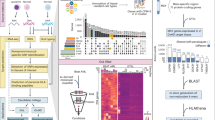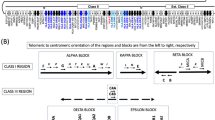Abstract
THE major histocompatibility complex (MHC) is a genetic region in mammals that controls various immunologically related phenomena. For example, the major histocompatibility complex of the mouse, the H–2 complex, can be divided into four major regions—K, I, S and D—by recombinational analysis1,2. The K and D regions code for transplantation antigens, cell-surface glycoproteins of 45,000 molecular weight which elicit skin, tissue and tumour graft rejection. The I region codes for immune response genes and for the Ia poly-peptides, cell-surface glycoproteins composed of heterodimers of approximately 35,000 and 28,000 MW, respectively3,4. The S region contains structural or regulatory genes that control the levels of certain complement components5,6. Functional and genetic analyses of these immunological traits suggest that these apparently disparate functions may be closely linked in the major histocompatibility complex of other mammals as well as the mouse7. The major histocompatibility complexes of humans, guinea pigs, rats and mice have been shown to have certain significant structural homologies to one another. In rats, the MHC is designated AgB or H–1 (refs 8 and 9, respectively). To date, at least 13 haplotypes, or combinations of allelic, linked genes within AgB, have been identified, based on data from skin grafting and serological testing (ref. 10 and O. Stark, personal communication). Here we present the partial N-terminal sequences of the transplantation antigens isolated from rats of the AgB4 haplotype. Our results demonstrate that the rat AgB4 transplantation antigen is homologous to those of the mouse, human and guinea pig. The sequence data also suggest that at least two major components are present. These sequences may represent the rat homologues of the mouse K and D transplantation antigens.
This is a preview of subscription content, access via your institution
Access options
Subscribe to this journal
Receive 51 print issues and online access
$199.00 per year
only $3.90 per issue
Buy this article
- Purchase on SpringerLink
- Instant access to full article PDF
Prices may be subject to local taxes which are calculated during checkout
Similar content being viewed by others
References
Shreffler, D. C. & David, C. S. Adv. Immun. 20, 125–195 (1975).
Klein, J. Biology of the Mouse Histocompatibility-2 Complex (Springer, New York, 1975).
Cullen, S. E., Freed, J. H. & Nathenson, S. G. Transplant. Rev. 30, 236–239 (1976).
Silver, J., Cecka, J. M., McMillan, M. & Hood, L. Cold Spring Harb. Symp. quant. Biol. 41, 369–377 (1976).
Démant, P., Capková, J., Hinzová, E. & Vorácová, B. Proc. natn. Acad. Sci. U.S.A. 70, 863–864 (1973).
Ferreira, A. & Nussenzweig, V. J. exp. med. 141, 513–517 (1975).
Klein, J. in The Major Histocompatibility System in Man and Animals (ed. Götze, D.) (Springer, New York, 1977).
Palm, J. Transplantation 11, 175–183 (1971).
Stark, O., Kren, V. & Günther, E. Transplant. Proc. 3, 165–168 (1971).
Kunz, H. W. & Gill, T. J. J. Immunogen. 1, 413–420 (1974).
Zaleska-Rutczynska, Z. & Klein, J. J. Immun. 119, 1903–1911 (1977).
Shonnard, J. W., Cramer, D. V., Poloskey, P. E., Kunz, H. W. & Gill, T. J. Immuno-genetics 3, 193–200 (1976).
McMillan, M., Cecka, J. M., Murphy, D. B., McDevitt, H. O. & Hood, L. Proc. natn. Acad. Sci. U.S.A. 74, 5135–5139 (1977).
Schwartz, B. D., Kask, A. M. & Shevach, E. M. Cold Spring Harb. Symp. quant. Biol. 41, 397 (1976).
McMillan, M., Schwartz, B. D. & Hood, L. (in preparation).
Galfre, G., Howe, S. C., Milstein, C., Butcher, G. W. & Howard, J. C. Nature 266, 550–552 (1977).
Butcher, G. W. & Howard, J. C. Nature 266, 362–364 (1977).
Cullen, S. E. & Schwartz, B. D. J. Immun. 117, 136–142 (1976).
Cold Spring Harb. Symp. quant. Biol. 41, 405 (1976).
Author information
Authors and Affiliations
Rights and permissions
About this article
Cite this article
BLANKENHORN, E., CECKA, J., HOOD, L. et al. Partial N-terminal amino acid sequence of rat transplantation antigens. Nature 274, 90–92 (1978). https://doi.org/10.1038/274090a0
Received:
Accepted:
Published:
Issue date:
DOI: https://doi.org/10.1038/274090a0
This article is cited by
-
Comparison of rat MHC class I antigens by peptide mapping
Immunogenetics (1987)
-
Polymorphism and mapping of the class II genes in the rat: RT1.B, RT1.D, and RT1.H, a new DP-like region
Immunogenetics (1987)
-
Orientation of the loci encoding RTI.B polypeptides in the major histocompatibility complex of the rat
Immunogenetics (1985)
-
Cytotoxic T lymphocytes of the rat are predominantly restricted by RTL1.A and Not RT1.C-determined major histocompatibility class I antigens
Immunogenetics (1984)
-
Biochemical characterization of Ia antigens encoded by theRT1.B andRT1.D loci in the rat MHC
Immunogenetics (1983)



